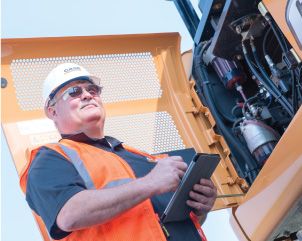Best Practices
How to Sanitize Heavy Equipment
Properly sanitizing heavy equipment is essential for maintaining the health, safety, and productivity of your team. Truck and machine cabs can be ideal environments for harboring and transmitting viruses and other illnesses. Despite the fact that operators are typically alone in the cab, all it takes is one mechanic, supervisor, or second shift operator to hop in there, touch a surface, and potentially be infected or leave traces of a virus.
Since the COVID-19 pandemic, many companies have a heightened sense of awareness when it comes to maintaining cleanliness. Follow these heavy equipment sanitation tips to protect your team from coronaviruses, the flu, and any other pathogens that may strike.
Find the right disinfectant
Before you start actually sanitizing your construction machines, you have to find a disinfectant that is effective at eliminating the majority of viruses without damaging your equipment interior. To avoid harming or discoloring vinyl, plastics, leather, or other surface materials, we recommend using cleaners designed for automotive interiors, not general household.
Isopropyl based cleaning products can be used to sanitize the majority of hard and interior surfaces. When using an alcohol based cleaning solution, the CDC recommends concentrations of 70% or above. Follow the instructions on the product for concentration, application method, and contact time. If you are trying to deactivate or kill a specific virus, check the EPA-approved disinfectant list for detailed descriptions of which types of cleaners to use for certain pathogens.
You should consult your owner's manual for directions on how to clean monitors, touch screens and other sensitive surfaces without damaging them.
Wear personal protective equipment (PPE)
Once you have the proper cleaning solution, it's time to move into the cab. The person handling the sanitation should always wear latex or synthetic rubber gloves and a mask or face covering. Wearing personal protective equipment will ensure the team member is shielded from the cleaning chemicals, as well as prevent them from leaving traces of a virus on the surfaces they just wiped down.
Clean all interior surfaces likely to be touched
The most important parts of the cab to sanitize are the ones that we touch a lot. Those areas should be cleaned before each new person enters the machine and typically include all handles, joysticks, steering wheels, knobs, buttons, seat belts, seat belt latches, windows, and even floor mats. Spray surfaces with the cleaner and use a highly absorbent microfiber cloth to scrub and wipe dry. For sensitive electronic or display areas, use an EPA approved contactless product, which you can spray and let dry without needing to wipe off.
Other surfaces to pay attention to
Just as important as sanitizing interior hard surfaces are exterior surfaces. Spray, scrub, and wipe all machine touchpoints, including the dipstick, gas cap, engine access points, handles, latches, and anywhere else likely to have contact.
Although it typically does not have to be sanitized as often as hard surfaces, it's a good idea to clean your upholstery at least every week, if not more frequent. You will find a variety of upholstery products at any auto parts store. If applying your own solution, avoid using anything that contains bleach, as it will cause discoloring.
Wash surfaces before sanitizing
Before using your sanitizing solution to disinfect equipment, ensure all dirt and dust are washed off. Washing before disinfecting is especially important for your machine's exterior, but also for floor mats, handles, and anywhere else that is visibly dirty. Clearing dust and debris will make the sanitation process more effective.

